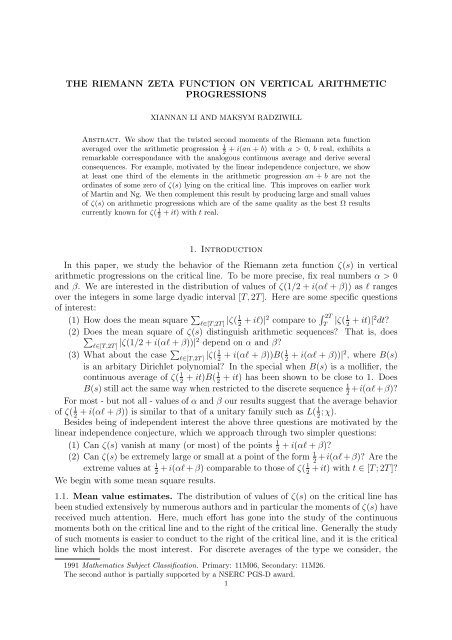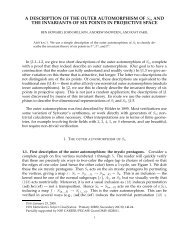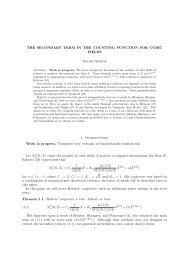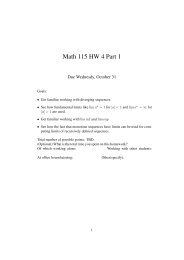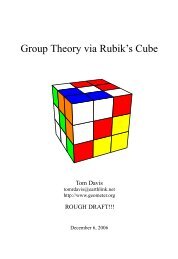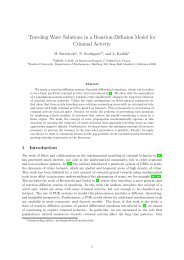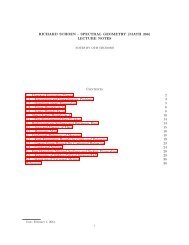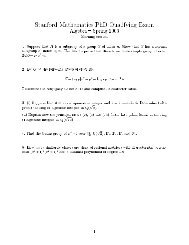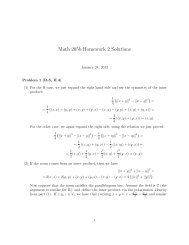The Riemann zeta-function on vertical arithmetic progressions
The Riemann zeta-function on vertical arithmetic progressions
The Riemann zeta-function on vertical arithmetic progressions
Create successful ePaper yourself
Turn your PDF publications into a flip-book with our unique Google optimized e-Paper software.
THE RIEMANN ZETA FUNCTION ON VERTICAL ARITHMETIC<br />
PROGRESSIONS<br />
XIANNAN LI AND MAKSYM RADZIWI̷L̷L<br />
Abstract. We show that the twisted sec<strong>on</strong>d moments of the <str<strong>on</strong>g>Riemann</str<strong>on</strong>g> <str<strong>on</strong>g>zeta</str<strong>on</strong>g> <str<strong>on</strong>g>functi<strong>on</strong></str<strong>on</strong>g><br />
averaged over the <strong>arithmetic</strong> progressi<strong>on</strong> 1<br />
2 + i(an + b) with a > 0, b real, exhibits a<br />
remarkable corresp<strong>on</strong>dance with the analogous c<strong>on</strong>tinuous average and derive several<br />
c<strong>on</strong>sequences. For example, motivated by the linear independence c<strong>on</strong>jecture, we show<br />
at least <strong>on</strong>e third of the elements in the <strong>arithmetic</strong> progressi<strong>on</strong> an + b are not the<br />
ordinates of some zero of ζ(s) lying <strong>on</strong> the critical line. This improves <strong>on</strong> earlier work<br />
of Martin and Ng. We then complement this result by producing large and small values<br />
of ζ(s) <strong>on</strong> <strong>arithmetic</strong> progressi<strong>on</strong>s which are of the same quality as the best Ω results<br />
currently known for ζ( 1<br />
2 + it) with t real.<br />
1. Introducti<strong>on</strong><br />
In this paper, we study the behavior of the <str<strong>on</strong>g>Riemann</str<strong>on</strong>g> <str<strong>on</strong>g>zeta</str<strong>on</strong>g> <str<strong>on</strong>g>functi<strong>on</strong></str<strong>on</strong>g> ζ(s) in <strong>vertical</strong><br />
<strong>arithmetic</strong> progressi<strong>on</strong>s <strong>on</strong> the critical line. To be more precise, fix real numbers α > 0<br />
and β. We are interested in the distributi<strong>on</strong> of values of ζ(1/2 + i(αℓ + β)) as ℓ ranges<br />
over the integers in some large dyadic interval [T, 2T ]. Here are some specific questi<strong>on</strong>s<br />
of interest:<br />
(1) How does the mean square <br />
ℓ∈[T,2T ]<br />
|ζ( 1<br />
2 + iℓ)|2 compare to 2T<br />
T |ζ( 1<br />
2 + it)|2 dt?<br />
(2) Does the mean square of ζ(s) distinguish <strong>arithmetic</strong> sequences? That is, does<br />
<br />
ℓ∈[T,2T ] |ζ(1/2 + i(αℓ + β))|2 depend <strong>on</strong> α and β?<br />
(3) What about the case <br />
ℓ∈[T,2T ]<br />
|ζ( 1<br />
2<br />
+ i(αℓ + β))B( 1<br />
2 + i(αℓ + β))|2 , where B(s)<br />
is an arbitary Dirichlet polynomial? In the special when B(s) is a mollifier, the<br />
+ it) has been shown to be close to 1. Does<br />
c<strong>on</strong>tinuous average of ζ( 1<br />
2<br />
+ it)B( 1<br />
2<br />
B(s) still act the same way when restricted to the discrete sequence 1<br />
2 +i(αℓ+β)?<br />
For most - but not all - values of α and β our results suggest that the average behavior<br />
of ζ( 1<br />
1<br />
+ i(αℓ + β)) is similar to that of a unitary family such as L( ; χ).<br />
2 2<br />
Besides being of independent interest the above three questi<strong>on</strong>s are motivated by the<br />
linear independence c<strong>on</strong>jecture, which we approach through two simpler questi<strong>on</strong>s:<br />
(1) Can ζ(s) vanish at many (or most) of the points 1 + i(αℓ + β)?<br />
2<br />
(2) Can ζ(s) be extremely large or small at a point of the form 1 + i(αℓ + β)? Are the<br />
2<br />
extreme values at 1<br />
1<br />
+ i(αℓ + β) comparable to those of ζ( + it) with t ∈ [T ; 2T ]?<br />
2 2<br />
We begin with some mean square results.<br />
1.1. Mean value estimates. <str<strong>on</strong>g>The</str<strong>on</strong>g> distributi<strong>on</strong> of values of ζ(s) <strong>on</strong> the critical line has<br />
been studied extensively by numerous authors and in particular the moments of ζ(s) have<br />
received much attenti<strong>on</strong>. Here, much effort has g<strong>on</strong>e into the study of the c<strong>on</strong>tinuous<br />
moments both <strong>on</strong> the critical line and to the right of the critical line. Generally the study<br />
of such moments is easier to c<strong>on</strong>duct to the right of the critical line, and it is the critical<br />
line which holds the most interest. For discrete averages of the type we c<strong>on</strong>sider, the<br />
1991 Mathematics Subject Classificati<strong>on</strong>. Primary: 11M06, Sec<strong>on</strong>dary: 11M26.<br />
<str<strong>on</strong>g>The</str<strong>on</strong>g> sec<strong>on</strong>d author is partially supported by a NSERC PGS-D award.<br />
1
fourth moment of ζ(s) has been studied to the right of the critical line by A. Good [3].<br />
C<strong>on</strong>sider a Dirichlet polynomial B(s) with,<br />
(1) B(s) = <br />
n≤T θ<br />
b(n)<br />
, and b(n) ≪ dA(n)<br />
ns for some fixed, but arbitrary A > 0. Throughout we will assume that the coefficients<br />
b(n) are real.<br />
<str<strong>on</strong>g>The</str<strong>on</strong>g>orem 1. Let B(s) be as above. Let φ(·) be a smooth compactly supported <str<strong>on</strong>g>functi<strong>on</strong></str<strong>on</strong>g>,<br />
with support in [1, 2]. If θ < 1,<br />
then as T → ∞.<br />
2<br />
<br />
|ζ( 1<br />
1 + iℓ)B( 2 2 + iℓ)|2 <br />
ℓ<br />
· φ = |ζ(<br />
T <br />
1<br />
1 + it)B( 2 2 + it)|2 <br />
t<br />
· φ dt + OA(T (log T )<br />
T<br />
−A )).<br />
ℓ<br />
Since ζ(s)B(s) oscillates <strong>on</strong> a scale of 2π/ log T it is interesting that we can rec<strong>on</strong>struct<br />
accurately the c<strong>on</strong>tinuous average of ζ(s)B(s) <strong>on</strong>ly by sampling at the integers. <str<strong>on</strong>g>The</str<strong>on</strong>g><br />
reader may be amused by examining the same statement for sin x or sin(log(|x| + 1)x),<br />
which will be equivalent to the equidistributi<strong>on</strong> of certain sequences modulo 1.<br />
<str<strong>on</strong>g>The</str<strong>on</strong>g>orem 1 depends <strong>on</strong> the fact that we are summing over the integers, and specifically<br />
<strong>on</strong> the fact that the sequence e2πℓ cannot be well approximated by rati<strong>on</strong>al numbers. To<br />
amplify this dependence, let us c<strong>on</strong>sider the sec<strong>on</strong>d moment of ζ(s) averaged over an<br />
<strong>arithmetic</strong> progressi<strong>on</strong> αn + β, with arbitrary α > 0 and β. In this c<strong>on</strong>text, our result<br />
will depend <strong>on</strong> the diophantine properties of e2πℓ/α . Let<br />
<br />
2πℓ/α 0 if e is irrati<strong>on</strong>al for all ℓ > 0<br />
δ(α, β) =<br />
2 cos(β log(m/n)) √ mn−2<br />
mn+1−2 √ mn cos(β log(m/n))<br />
if e 2πℓ/α is rati<strong>on</strong>al for some ℓ > 0<br />
with m/n = 1 denoting the smallest reduced fracti<strong>on</strong> having a representati<strong>on</strong> in the form<br />
e 2πℓ/α for some ℓ > 0. <str<strong>on</strong>g>The</str<strong>on</strong>g>n we have the following asymptotic result for the sec<strong>on</strong>d<br />
moment of the <str<strong>on</strong>g>Riemann</str<strong>on</strong>g> <str<strong>on</strong>g>zeta</str<strong>on</strong>g> <str<strong>on</strong>g>functi<strong>on</strong></str<strong>on</strong>g>.<br />
<str<strong>on</strong>g>The</str<strong>on</strong>g>orem 2. Let φ(·) be a smooth compactly supported <str<strong>on</strong>g>functi<strong>on</strong></str<strong>on</strong>g>, with support in [1, 2].<br />
Let α > 0, β be real numbers. <str<strong>on</strong>g>The</str<strong>on</strong>g>n, as T → ∞,<br />
<br />
|ζ( 1<br />
2 + i(αℓ + β))|2 <br />
ℓ<br />
· φ = |ζ(<br />
T <br />
1<br />
2 + i(αt + β))|2 <br />
t<br />
· φ dt · (1 + δ(α, β) + o(1))<br />
T<br />
ℓ<br />
In the above, o(1) denotes a quantity tending to 0 as T grows, which depends <strong>on</strong> the<br />
diophantine properties of α and β. Our methods allow us to prove an analogous result for<br />
the sec<strong>on</strong>d moment of ζ(s) twisted by a Dirichlet polynomial over an arbitrary <strong>vertical</strong><br />
<strong>arithmetic</strong> progressi<strong>on</strong> and also to recover Good’s estimate [3] for the fourth moment of<br />
the <str<strong>on</strong>g>Riemann</str<strong>on</strong>g> <str<strong>on</strong>g>zeta</str<strong>on</strong>g>-<str<strong>on</strong>g>functi<strong>on</strong></str<strong>on</strong>g> off the half-line. See Propositi<strong>on</strong>s 1 and 2 for more details.<br />
In c<strong>on</strong>trast to <str<strong>on</strong>g>The</str<strong>on</strong>g>orem 2, the dependence <strong>on</strong> the diophantine properties of α and β is<br />
nullified when B is a mollifier. To be precise, let φ(·) be a smooth compactly supported<br />
<str<strong>on</strong>g>functi<strong>on</strong></str<strong>on</strong>g>, with support in [1, 2], and define<br />
Mθ(s) := µ(n)<br />
ns <br />
log n<br />
· 1 −<br />
log T θ<br />
<br />
.<br />
<str<strong>on</strong>g>The</str<strong>on</strong>g>n we have the following <str<strong>on</strong>g>The</str<strong>on</strong>g>orem.<br />
ℓ<br />
n≤T θ<br />
<str<strong>on</strong>g>The</str<strong>on</strong>g>orem 3. Let the mollified sec<strong>on</strong>d moment be defined as<br />
(2) J := <br />
|ζ( 1<br />
1<br />
+ i(αℓ + β))Mθ( 2 2 + i(αℓ + β))|2 <br />
ℓ<br />
φ .<br />
T<br />
2
Let 0 < θ < 1 and a > 0 and b be real numbers. <str<strong>on</strong>g>The</str<strong>on</strong>g>n,<br />
2<br />
<br />
<br />
J = (ζ · Mθ)(<br />
<br />
1<br />
2 + i(αt + β))|2 <br />
t<br />
T<br />
· φ dt + O<br />
T (log T ) 1−ε<br />
<br />
<str<strong>on</strong>g>The</str<strong>on</strong>g> lack of dependence <strong>on</strong> the diophantine properties of α and β in <str<strong>on</strong>g>The</str<strong>on</strong>g>orem 3 gives<br />
in <str<strong>on</strong>g>The</str<strong>on</strong>g>orem 4 below.<br />
the n<strong>on</strong>-vanishing proporti<strong>on</strong> of 1<br />
3<br />
1.2. N<strong>on</strong>-vanishing results. One of the fundamental problems in analytic number theory<br />
is determinati<strong>on</strong> of the locati<strong>on</strong> of the zeros of L-<str<strong>on</strong>g>functi<strong>on</strong></str<strong>on</strong>g>s. Here, <strong>on</strong>e deep c<strong>on</strong>jecture<br />
about the <strong>vertical</strong> distributi<strong>on</strong> of zeros of ζ(s) is the Linear Independence C<strong>on</strong>jecture (LI),<br />
which states that the ordinates of n<strong>on</strong>-trivial zeros of ζ(s) are linearly independent over<br />
Q. In general, it is believed that the zeros of L-<str<strong>on</strong>g>functi<strong>on</strong></str<strong>on</strong>g>s do not satisfy any algebraic<br />
relati<strong>on</strong>s, but rather appear to be “random” transcendental numbers. Classically, Ingham<br />
[4] linked the linear independence c<strong>on</strong>jecture for the <str<strong>on</strong>g>Riemann</str<strong>on</strong>g> <str<strong>on</strong>g>zeta</str<strong>on</strong>g>-<str<strong>on</strong>g>functi<strong>on</strong></str<strong>on</strong>g> with<br />
the oscilati<strong>on</strong>s of M(x) = <br />
n≤x µ(n), in particular offering a c<strong>on</strong>diti<strong>on</strong>al disproof of<br />
Merten’s c<strong>on</strong>jecture that |M(x)| ≤ √ x for all x large enough. <str<strong>on</strong>g>The</str<strong>on</strong>g>re are a number of<br />
c<strong>on</strong>necti<strong>on</strong>s between LI and the distributi<strong>on</strong> of primes. For instance, Rubinstein and<br />
Sarnak [9] showed a c<strong>on</strong>necti<strong>on</strong> between LI for Dirichlet L-<str<strong>on</strong>g>functi<strong>on</strong></str<strong>on</strong>g>s and prime number<br />
races, and this has appeared in the work of many subsequent authors.<br />
LI appears to be far out of reach of current technology. However, it implies easier<br />
c<strong>on</strong>jectures which may be more tractable. One of these is that the <strong>vertical</strong> ordinates of<br />
n<strong>on</strong>trivial zeros of ζ(s) should not lie in an <strong>arithmetic</strong> progressi<strong>on</strong>. To be more precise,<br />
for fixed α > 0, β ∈ , let<br />
Pα,β(T ) = 1<br />
1<br />
· Card{T ≤ ℓ ≤ 2T : ζ( + i(αℓ + β)) = 0}.<br />
2 T<br />
<str<strong>on</strong>g>The</str<strong>on</strong>g>n what kind of lower bounds can we prove for Pα,β(T ) for large T ? Recently, improving<br />
<strong>on</strong> the work of numerous earlier authors, Martin and Ng [8] showed that Pα,β(T ) ≫α,β<br />
(log T ) −1 which misses the truth by a factor of log T . In this paper, we prove the following<br />
improvement.<br />
<str<strong>on</strong>g>The</str<strong>on</strong>g>orem 4. Let α > 0 and β be real. <str<strong>on</strong>g>The</str<strong>on</strong>g>n, as T → ∞,<br />
Pα,β(T ) ≥ 1<br />
+ o(1).<br />
3<br />
<str<strong>on</strong>g>The</str<strong>on</strong>g> proof of <str<strong>on</strong>g>The</str<strong>on</strong>g>orem 4 leads easily to the result below.<br />
Corollary 1. Let α > 0 and β be real. <str<strong>on</strong>g>The</str<strong>on</strong>g>n, as T → ∞,<br />
for more than ( 1<br />
3<br />
|ζ( 1 + i(αℓ + β)| ≥ ε(log ℓ)−1/2<br />
2<br />
− Cε)T integers T ≤ ℓ ≤ 2T , with C an absolute c<strong>on</strong>stant.<br />
<str<strong>on</strong>g>The</str<strong>on</strong>g>orem 4 is proven by understanding both a mollifed discrete sec<strong>on</strong>d moment (see<br />
<str<strong>on</strong>g>The</str<strong>on</strong>g>orem 3) and a mollified discrete first moment. Our methods extend without modifi-<br />
cati<strong>on</strong> to prove the analogous result for Dirichlet L-<str<strong>on</strong>g>functi<strong>on</strong></str<strong>on</strong>g>s. <str<strong>on</strong>g>The</str<strong>on</strong>g> c<strong>on</strong>stants 1<br />
3 represents<br />
the limits of the current technology - see for example [5] for the case of n<strong>on</strong>-vanishing of<br />
Dirichlet L-<str<strong>on</strong>g>functi<strong>on</strong></str<strong>on</strong>g>s at the critical point.<br />
Of course, we expect that Pα,β(T ) = 1 + O(T −1 ). Assuming the <str<strong>on</strong>g>Riemann</str<strong>on</strong>g> Hypothesis<br />
(RH), Ford, Soundararajan and Zaharescu [2] showed Pα,β(T ) ≥ 1 + o(1) as T →<br />
2<br />
∞. Assuming RH and M<strong>on</strong>tgomery’s Pair Correlati<strong>on</strong> C<strong>on</strong>jecture they showed [2] that<br />
Pα,β(T ) ≥ 1 − o(1) as T → ∞. Assuming a very str<strong>on</strong>g hypothesis <strong>on</strong> the distributi<strong>on</strong><br />
of primes in short intervals, it is possible to show that Pα,β(T ) = 1 − O(T −δ ) for some<br />
δ > 0.<br />
3
Note that the rigid structure of the <strong>arithmetic</strong> progressi<strong>on</strong> is important. Since there<br />
is a zero of ζ(s) in every interval of size essentially (log log log T ) −1 in [T, 2T ] (see [7])<br />
minor perturbati<strong>on</strong>s of the <strong>arithmetic</strong> progressi<strong>on</strong> renders our result false.<br />
1.3. Large and small values. We now complement <str<strong>on</strong>g>The</str<strong>on</strong>g>orem 4 by exhibiting large and<br />
small values of ζ(s) at discrete points 1 + i(αℓ + β) using Soundararajan’s res<strong>on</strong>ance<br />
2<br />
method [10]. Previously A. Good pointed out in [3] that his result imply that ζ(σ +<br />
and infinitely many ℓ’s.<br />
i(αℓ + β)) = Ω(1) for fixed σ > 1<br />
2<br />
<str<strong>on</strong>g>The</str<strong>on</strong>g>orem 5. Let α > 0 and β be real. <str<strong>on</strong>g>The</str<strong>on</strong>g>n, for infinitely many ℓ > 0,<br />
|ζ( 1<br />
<br />
log ℓ<br />
+ i(αℓ + β))| ≫ exp (1 + o(1))<br />
2 6 log log ℓ<br />
and for infinitely many ℓ,<br />
|ζ( 1<br />
<br />
+ i(αℓ + β))| ≪ exp<br />
2<br />
− (1 + o(1))<br />
<br />
log ℓ<br />
.<br />
6 log log ℓ<br />
<str<strong>on</strong>g>The</str<strong>on</strong>g> o(1) in this result is independent of the diophantine properties of α and β. Since<br />
we expect ζ( 1 + i(αℓ + β)) = 0 for essentially all ℓ, it is interesting to produce values<br />
2<br />
of ℓ at which ζ( 1 + i(αℓ + β)) is extremely small. Furthermore, the large values of<br />
2<br />
ζ( 1 + i(αℓ + β)) over a discrete set of points above are almost of the same quality as the<br />
2<br />
best results for large values of ζ( 1 + it) with t real. In the latter case, the best result is<br />
2<br />
due to Soundararajan [10]. We have not tried to optimize in <str<strong>on</strong>g>The</str<strong>on</strong>g>orem 5 and perhaps the<br />
same methods might lead to the c<strong>on</strong>stant 1 rather than 1/ √ 6.<br />
1.4. Technical propositi<strong>on</strong>s. <str<strong>on</strong>g>The</str<strong>on</strong>g> proofs of our <str<strong>on</strong>g>The</str<strong>on</strong>g>orems rests <strong>on</strong> a technical Propositi<strong>on</strong>,<br />
and its variant, which may be of independent interest. With B(s) defined as in<br />
(1), c<strong>on</strong>sider the difference between the discrete average and the c<strong>on</strong>tinuous average,<br />
E := <br />
|(ζ · B)( 1<br />
2 + i(αℓ + β))|2 <br />
ℓ<br />
φ − |(ζ · B)(<br />
T <br />
1<br />
2 + i(αt + β))|2 <br />
t<br />
φ dt.<br />
T<br />
ℓ<br />
Propositi<strong>on</strong> 1 below shows that understanding E boils down to understanding the behavior<br />
of sums of the form<br />
(3) F (aℓ, bℓ, t) := 1<br />
r<br />
r1<br />
<br />
h,kT θ<br />
where W (x) is a smooth <str<strong>on</strong>g>functi<strong>on</strong></str<strong>on</strong>g> defined as<br />
W (x) := 1<br />
<br />
2πi<br />
b(k)b(h) <br />
(ε)<br />
m,n1<br />
mk=aℓr<br />
nh=bℓr<br />
x −w · G(w) dw<br />
w<br />
<br />
2πmn<br />
W<br />
αt + β<br />
with G(w) an entire <str<strong>on</strong>g>functi<strong>on</strong></str<strong>on</strong>g> of rapid decay al<strong>on</strong>g <strong>vertical</strong> lines G(x + iy) ≪x,A |y| −A ,<br />
such that G(w) = G(−w), G(0) = 1, and satisfying G( ¯w) = G(w) (to make W (x) real<br />
valued for x real). For example we can take G(w) = ew2. Notice that W (x) ≪ 1 for<br />
x ≤ 1 and W (x) ≪A x−A for x > 1.<br />
Of course, the expressi<strong>on</strong> in (3) should not depend <strong>on</strong> the choice of W . In fact,<br />
F (al, bl, t) can also be written as<br />
<br />
<br />
b(m)b(n)<br />
(4)<br />
· (maℓ, nbℓ) · H (αt + β) ·<br />
mn<br />
(maℓ, nbℓ) 2 <br />
2πmaℓnbℓ<br />
m,n≤T θ<br />
4
where H(x) is a smooth <str<strong>on</strong>g>functi<strong>on</strong></str<strong>on</strong>g> such that,<br />
<br />
1<br />
H(x) = 2 · log x + γ + OA(x−A ) if x ≫ 1<br />
OA(xA ) if x ≪ 1<br />
As seen in a theorem of Balasubramanian, C<strong>on</strong>rey and Heath-Brown [1] the c<strong>on</strong>tinuous<br />
t average over T ≤ t ≤ 2T of |ζ( 1<br />
2<br />
technical reas<strong>on</strong>s it is more c<strong>on</strong>venient for us to work with the smooth versi<strong>on</strong> (3).<br />
+ it)B( 1<br />
2 + it)|2 gives rise to (4) with aℓ = 1 = bℓ. For<br />
Propositi<strong>on</strong> 1. Let 0 < θ < 1/2. For each ℓ > 0, let (aℓ, bℓ) denote (if it exists) the<br />
unique tuple of co-prime integers such that aℓbℓ > 1, bℓ < T 1/2−εe−πℓ/α and<br />
<br />
aℓ<br />
(5)<br />
<br />
− e 2πℓ/α<br />
<br />
<br />
<br />
<br />
bℓ<br />
e2πℓ/α<br />
≤ .<br />
T 1−ɛ<br />
If such a pair (aℓ, bℓ) exists, then let<br />
iβ ∞ aℓ<br />
(aℓ/bℓ) t<br />
α log bℓ<br />
H(ℓ) = √ φ · exp − 2πit<br />
aℓbℓ −∞ T<br />
2π<br />
and otherwise set H(ℓ) = 0. <str<strong>on</strong>g>The</str<strong>on</strong>g>n,<br />
E = 4Re <br />
H(ℓ) + O(T 1−ε ).<br />
ℓ>0<br />
More generally we can c<strong>on</strong>sider<br />
E ′ = <br />
|B( 1<br />
2 + i(αℓ + β))|2 <br />
ℓ<br />
φ −<br />
T <br />
ℓ<br />
In this case our results depend <strong>on</strong><br />
F ′ (aℓ, bℓ) := <br />
r≥1<br />
<br />
− ℓ · F (aℓ, bℓ, t)dt,<br />
|B( 1<br />
2 + i(αt + β))|2 <br />
t<br />
φ dt.<br />
T<br />
b(aℓr)b(bℓr)<br />
r<br />
where we adopted the c<strong>on</strong>venti<strong>on</strong> that b(n) = 0 for n > T θ . <str<strong>on</strong>g>The</str<strong>on</strong>g>n the analogue of<br />
Propositi<strong>on</strong> 1 is stated below.<br />
Propositi<strong>on</strong> 2. Let 0 < θ < 1. For each ℓ > 0 let (aℓ, bℓ) denote (if it exists) the unique<br />
tuple of co-prime integers such that aℓbℓ > 1, bℓ < T 1/2−εe−πℓ/α and<br />
<br />
aℓ<br />
(6)<br />
<br />
− e 2πℓ/α<br />
<br />
<br />
<br />
<br />
<str<strong>on</strong>g>The</str<strong>on</strong>g>n,<br />
E ′ = 2ℜ <br />
ℓ>0<br />
bℓ<br />
(aℓ/bℓ) iβ<br />
√ aℓbℓ<br />
· ˆ aℓ α log bℓ φ<br />
2π<br />
e2πℓ/α<br />
≤ .<br />
T 1−ɛ<br />
<br />
− ℓ F ′<br />
(aℓ, bℓ) + O(T 1−ε )<br />
where in the summati<strong>on</strong> over ℓ we omit the terms for which the pair (aℓ, bℓ) does not<br />
exist.<br />
<str<strong>on</strong>g>The</str<strong>on</strong>g> proof of Propositi<strong>on</strong> 2 is very similar (in fact easier!) than that of Propositi<strong>on</strong> 1,<br />
and for this reas<strong>on</strong> we omit it. To recover Good’s result [3] for the fourth moment of<br />
the <str<strong>on</strong>g>Riemann</str<strong>on</strong>g> <str<strong>on</strong>g>zeta</str<strong>on</strong>g>-<str<strong>on</strong>g>functi<strong>on</strong></str<strong>on</strong>g> off the half-line, we <strong>on</strong>ly need Propositi<strong>on</strong> 2 for a Dirichlet<br />
polynomial of length T ε .<br />
One can ask about the typical distributi<strong>on</strong> of log ζ( 1 + i(αℓ + β)) . This questi<strong>on</strong> is<br />
out of reach if we focus <strong>on</strong> the real part of log ζ(s) since we cannot even guarantee that<br />
almost all 1<br />
2<br />
+ i(αℓ + β) are not zeros of the <str<strong>on</strong>g>Riemann</str<strong>on</strong>g> <str<strong>on</strong>g>zeta</str<strong>on</strong>g>-<str<strong>on</strong>g>functi<strong>on</strong></str<strong>on</strong>g>. On the <str<strong>on</strong>g>Riemann</str<strong>on</strong>g><br />
5<br />
2
Hypothesis, using Propositi<strong>on</strong> 2 and Selberg’s methods, <strong>on</strong>e can prove a central limit<br />
theorem for S(αℓ + β) with T ≤ ℓ ≤ 2T . We will not pursue this applicati<strong>on</strong> here.<br />
We deduce <str<strong>on</strong>g>The</str<strong>on</strong>g>orems 1 and 2 from Propositi<strong>on</strong> 1 in Secti<strong>on</strong> 2. We then prove <str<strong>on</strong>g>The</str<strong>on</strong>g>orem<br />
3 in Secti<strong>on</strong> 3, complete the proof of <str<strong>on</strong>g>The</str<strong>on</strong>g>orem 4 in Secti<strong>on</strong> 4, and prove <str<strong>on</strong>g>The</str<strong>on</strong>g>orem 5 in<br />
Secti<strong>on</strong> 5. Finally, we prove Propositi<strong>on</strong> 1 in Secti<strong>on</strong> 6.<br />
2. Proof of <str<strong>on</strong>g>The</str<strong>on</strong>g>orems 1 and 2<br />
Proof of <str<strong>on</strong>g>The</str<strong>on</strong>g>orem 1. Set α = 1 and β = 0. By Propositi<strong>on</strong> 1 it is enough to show that<br />
E ≪ T (log T ) −A . Since W (x) ≪ x−A for x > 1 and W (x) ≪ 1 for x ≤ 1, we have, for<br />
T ≤ t ≤ 2T<br />
F (aℓ, bℓ, t) ≪ 1 + <br />
r≥1<br />
1<br />
r<br />
<br />
h,k≤T θ<br />
|b(k)b(h)| <br />
m,n≤T 1+ε<br />
mk=aℓr<br />
nh=bℓr<br />
1 ≪ <br />
r≤T 2<br />
c(aℓr)c(bℓr)<br />
r<br />
where c(n) := <br />
d|n |b(d)| ≪ dA+1(n). <str<strong>on</strong>g>The</str<strong>on</strong>g>refore F (aℓ, bℓ, t) ≪ (aℓbℓ) εT (log T ) B . for some<br />
large B > 0. It thus follows by Propositi<strong>on</strong> 1, that<br />
E ≪ T (log T ) B · <br />
(aℓbℓ) −1/2+ε<br />
Because of (6) we have aℓbℓ ≫ e 2πℓ . <str<strong>on</strong>g>The</str<strong>on</strong>g>refore the ℓ’s with ℓ ≥ (log log T ) 1+ε c<strong>on</strong>tribute<br />
≪A T (log T ) −A . We can therefore subsequently assume that ℓ ≪ (log log T ) 1+ε . In order<br />
to c<strong>on</strong>trol aℓ and bℓ, when ℓ ≤ (log log T ) 1+ε we appeal to a result of Waldschmidt (see<br />
[11], p. 473),<br />
(7)<br />
<br />
<br />
<br />
eπm − p<br />
<br />
<br />
<br />
q <br />
ℓ>0<br />
<br />
≥ exp − 2 72 <br />
log(2m) log p · log log p .<br />
<str<strong>on</strong>g>The</str<strong>on</strong>g>refore if c<strong>on</strong>diti<strong>on</strong> (6) is satisfied then e 2πℓ T −1+ε ≥ exp(−c(log ℓ) · (log aℓ)(log log aℓ))<br />
<str<strong>on</strong>g>The</str<strong>on</strong>g>refore, using that ℓ ≤ (log log T ) 1+ε we get (log aℓ) · (log log aℓ) ≫ log T/(log log T ) ε ,<br />
and hence log aℓ ≫ log T/(log log T ) 1+ε . Notice also that (6) implies that aℓbℓ ≫ e 2πℓ , so<br />
that <br />
ℓ>0 (aℓbℓ) −α = Oα(1) for any α > 0. Combining these observati<strong>on</strong>s we find<br />
<br />
<br />
−c log T/(log log T )1+ε −c log T/(log log T )1+ε<br />
0 0, as desired. <br />
It is possible to generalize this theorem to other progressi<strong>on</strong>s, for example to those<br />
for which 2π/α is algebraic. We refer the reader to [11] for the necessary results in<br />
diophantine approximati<strong>on</strong>.<br />
Proof of <str<strong>on</strong>g>The</str<strong>on</strong>g>orem 2. Set B(s) = 1 in Propositi<strong>on</strong> 1. <str<strong>on</strong>g>The</str<strong>on</strong>g>n, keeping notati<strong>on</strong> as in Propositi<strong>on</strong><br />
1, we get<br />
<br />
|ζ( 1<br />
2 + i(αℓ + β))|2 <br />
ℓ<br />
· φ = |ζ(<br />
T <br />
1<br />
2 + i(αt + β))|2 <br />
t<br />
· φ dt + E<br />
T<br />
ℓ<br />
<str<strong>on</strong>g>The</str<strong>on</strong>g> main term is ∼ ˆ φ(0)T log T . It remains to understand E.<br />
First case. First suppose that e 2πℓ/α is irrati<strong>on</strong>al for all ℓ > 0. Since b(k) = 1 if<br />
6<br />
+ 1<br />
.
k = 1 and b(k) = 0 otherwise it is easy to see that F (aℓ, bℓ, t) ≪ T log T uniformly in<br />
aℓ, bℓ and T ≤ t ≤ 2T . Thus,<br />
E ≪ T log T <br />
(aℓbℓ) −1/2<br />
It remains to show that <br />
ℓ>0 (aℓbℓ) −1/2 = o(1) as T → ∞. Let ε > 0 be given. Since<br />
aℓbℓ ≫ e2πℓ/α we can find an A such that <br />
ℓ>A (aℓbℓ) −1/2 ≤ ε. For the remaining integers<br />
ℓ ≤ A notice that e2πℓ/α is irrati<strong>on</strong>al for each ℓ ≤ A. <str<strong>on</strong>g>The</str<strong>on</strong>g>refore for each ℓ ≤ A,<br />
(8)<br />
<br />
<br />
<br />
<br />
aℓ<br />
bℓ<br />
ℓ>0<br />
− e 2πℓ/α<br />
<br />
<br />
<br />
<br />
≤ e2πℓ/α<br />
T 1−ε<br />
implies that aℓbℓ → ∞. It follows that <br />
ℓ≤A (aℓbℓ) −1/2 ≤ ε <strong>on</strong>ce T is large enough. We<br />
c<strong>on</strong>clude that <br />
ℓ>0 (aℓbℓ) −1/2 = o(1), and hence that E = o(T log T ) as desired.<br />
Sec<strong>on</strong>d case. Now c<strong>on</strong>sider the case that e 2πℓ0/α is rati<strong>on</strong>al for some ℓ0. Write<br />
(9) α = 2πℓ0<br />
log(m/n)<br />
with co-prime m and n and |m| minimal. Let k be the maximal positive integer such<br />
that m/n = (r/s) k with r, s co-prime. <str<strong>on</strong>g>The</str<strong>on</strong>g>n,<br />
α = ℓ0<br />
k ·<br />
2π<br />
log(r/s) .<br />
Let d = (ℓ0, k). Note that d = 1 since otherwise, we may replace ℓ0 by ℓ0/d and m and<br />
n by m1/d and n1/d in (9) which c<strong>on</strong>tradicts the minimality c<strong>on</strong>diti<strong>on</strong> <strong>on</strong> |m|.<br />
For each ℓ divisible by ℓ0 the integers aℓ = mℓ/ℓ0 and bℓ = nℓ/ℓ0 satisfy (8) because<br />
e2πℓ/α = (m/n) ℓ/ℓ0 . For the remaining integers ℓ not divisible by ℓ0, e2πℓ/α = (r/s) kℓ/ℓ0 is<br />
irrati<strong>on</strong>al, since ℓ0|kℓ if and <strong>on</strong>ly if ℓ0|ℓ. We split E accordingly<br />
E = 4Re <br />
H(ℓ) + 4Re <br />
H(ℓ)<br />
ℓ>0<br />
ℓ0|ℓ<br />
<str<strong>on</strong>g>The</str<strong>on</strong>g> sec<strong>on</strong>d sum is o(T log T ) as can be seen by repeating the same argument as in the<br />
first case. As for the first sum, we find that for each ℓ divisible by ℓ0,<br />
iβ ℓ/ℓ0<br />
(m/n)<br />
H(ℓ) = 2Re √ ·<br />
mn<br />
ˆ <br />
ℓ log mn<br />
φ(0)T log T + O<br />
· T .<br />
ℓ/2ℓ0 (mn)<br />
<str<strong>on</strong>g>The</str<strong>on</strong>g>refore<br />
<br />
H(ℓ) = 2 ˆ φ(0)T log T · <br />
ℓ>0<br />
ℓ0|ℓ<br />
= ˆ φ(0)T log T ·<br />
ℓ>0<br />
ℓ>0<br />
ℓ0∤ℓ<br />
iβ ℓ<br />
(m/n)<br />
√ + O(T )<br />
mn<br />
2 cos(β log(m/n)) √ mn − 2<br />
mn + 1 − 2 √ + O(T )<br />
mn cos(β log(m/n))<br />
giving the desired estimate for E. <br />
7
3. Proof of <str<strong>on</strong>g>The</str<strong>on</strong>g>orem 3<br />
Recall that in the notati<strong>on</strong> of Propositi<strong>on</strong> 1,<br />
F (aℓ, bℓ, t) := <br />
r1<br />
1<br />
r<br />
<br />
h,kT θ<br />
b(k)b(h) <br />
m,n1<br />
mk=aℓr<br />
nh=bℓr<br />
<br />
2πmn<br />
W<br />
αt + β<br />
<str<strong>on</strong>g>The</str<strong>on</strong>g> lemma below, provides a bound for F when the coefficients b(n) are the coefficients<br />
of the mollifiers Mθ(s), that is<br />
and b(n) = 0 for n > T θ .<br />
b(n) = µ(n) ·<br />
<br />
log n<br />
1 −<br />
log T θ<br />
<br />
Lemma 1. For any aℓ, bℓ ∈ N with (aℓ, bℓ) = 1 and aℓbℓ > 1, uniformly in T ≤ t ≤ 2T ,<br />
we have that<br />
F (aℓ, bℓ, t) ≪ (aℓbℓ) ε · T (log T ) −1+ε .<br />
Proof. For notati<strong>on</strong>al ease, let N = T θ . We first express the c<strong>on</strong>diti<strong>on</strong>s in the sum above<br />
in terms of Mellin transforms. To be specific since<br />
W (x) = 1<br />
<br />
x<br />
2π (ε)<br />
−w G(w) dw<br />
w<br />
with G(w) rapidly decaying al<strong>on</strong>g <strong>vertical</strong> lines, and such that G(w) = G(−w), G(0) = 1,<br />
we have<br />
S = 1<br />
<br />
2πi<br />
=<br />
<br />
<br />
(2) m,n≥1 h,k≤N<br />
<br />
1<br />
3 <br />
2πi (2) (2) (2)<br />
b(h)b(k) <br />
<br />
m,n≥1<br />
r≥1<br />
nk=bℓr<br />
mh=aℓr<br />
1<br />
(mn) w<br />
1<br />
r<br />
<br />
h,k<br />
w αt + β<br />
G(w)<br />
2πmn<br />
dw<br />
w<br />
µ(h)µ(k)<br />
hz1kz2 <br />
r≥1<br />
nk=bℓr<br />
mh=aℓr<br />
1<br />
r<br />
αt + β<br />
2π<br />
w G(w) dw N<br />
w<br />
z1dz1 log Nz 2 N<br />
1<br />
z2dz2 log Nz 2 .<br />
2<br />
<str<strong>on</strong>g>The</str<strong>on</strong>g> sum over m, n, h, k and r inside the integral may be factored into an Euler product<br />
as<br />
<br />
1 1<br />
r n<br />
r≥1 nk=bℓr<br />
w<br />
µ(k)<br />
kz2 <br />
1<br />
m<br />
mh=aℓr<br />
w<br />
µ(h)<br />
hz1 <br />
= <br />
<br />
1 + 1<br />
<br />
1 1<br />
−<br />
p pw pz2 <br />
1 1<br />
−<br />
pw pz1 <br />
F (aℓbℓ, w, z1, z2)η(w, z1, z2).<br />
p<br />
8
Here η(w, z1, z2) is an Euler product which is absolutely c<strong>on</strong>vergent in the regi<strong>on</strong> delimited<br />
by Re w, Re z1, Re z2 > −1/2 and we define<br />
F (aℓbℓ, w, z1, z2) = <br />
pj 1<br />
p<br />
||aℓ<br />
(j−1)w<br />
<br />
1 1<br />
−<br />
pw pz1 <br />
1 + 1<br />
p1+w <br />
1 1<br />
−<br />
pw pz2 <br />
<br />
pj 1<br />
p<br />
||bℓ<br />
(j−1)w<br />
<br />
1 1<br />
−<br />
pw pz2 <br />
1 + 1<br />
p1+w <br />
1 1<br />
−<br />
pw pz1 <br />
<br />
<br />
1 + 1<br />
<br />
1 1<br />
−<br />
p pw pz2 <br />
1 1<br />
−<br />
pw pz1 −1 .<br />
Further, we may write<br />
<br />
p<br />
p∤aℓbℓ<br />
<br />
1 + 1<br />
<br />
1 1<br />
−<br />
p pw pz2 <br />
1 1<br />
−<br />
pw pz1 <br />
η(w, z1, z2) = ζ(1 + 2w)ζ(1 + z1 + z2)<br />
ζ(1 + w + z1)ζ(1 + w + z2) ˜η(w, z1, z2),<br />
where ˜η denotes an Euler product which is absolutely c<strong>on</strong>vergent in the regi<strong>on</strong> delimited<br />
by Re w, Re z1, Re z2 > −1/2 and does not depend <strong>on</strong> aℓ or bℓ. Thus,<br />
3 3 1<br />
ζ(1 + 2w)ζ(1 + z1 + z2)<br />
S =<br />
2πi<br />
ζ(1 + w + z!)ζ(1 + w + z2) ˜η(w, z1,<br />
w αt + β<br />
z2)F (aℓbℓ, w, z1, z2)<br />
2π<br />
(2)<br />
G(w) dw<br />
w<br />
N z1 dz1<br />
log Nz 2 1<br />
N z2 dz2<br />
log Nz 2 2<br />
and shifting c<strong>on</strong>tours to Re w = −δ, Re z1 = Re z2 = δ + δ2 gives, since αt + β ≍ T ,<br />
<br />
<br />
S = I1 + I2 + I3 + O<br />
(aℓbℓ) δ N 2δ+2δ2<br />
with I1, I2, I3 specified below. Since N < T 1/2−ε the error term is ≪ (aℓbℓ) ε T −ε provided<br />
that δ is chosen small enough. Writing<br />
H(z1, z2) = ζ(1 + z1 + z2)<br />
ζ(1 + z1)ζ(1 + z2) ˜η(0, z1, z2)F (aℓbℓ, 0, z1, z2)<br />
we have<br />
log(αt + β) 1<br />
I1 =<br />
2 (2πi) 2<br />
<br />
(1/4) (1/4)<br />
I2 = − 1 1<br />
2 (2πi) 2<br />
′ ζ<br />
ζ (1 + z1) + ζ′<br />
<br />
(1 + z2)<br />
ζ<br />
and<br />
I3 = 1 1<br />
2 (2πi) 2<br />
<br />
(1/4)<br />
(1/4)<br />
<br />
(1/4)<br />
(1/4)<br />
T δ<br />
H(z1, z2) · N z1 dz1<br />
log Nz 2 1<br />
N z2dz2 log Nz 2 ,<br />
2<br />
· H(z1, z2) · N z1 dz1<br />
log Nz 2 1<br />
<br />
d<br />
dw ˜η(w, z1, z2)F (aℓbℓ, w, z1, z2) <br />
w=0 · H(z1, z2)·<br />
˜η(0, z1, z2)F (aℓbℓ, 0, z1, z2)<br />
· N z1 dz1<br />
log Nz 2 1<br />
N z2dz2 log Nz 2 ,<br />
2<br />
N z2dz2 log Nz 2 .<br />
2<br />
Bounding the integrals is now a standard exercise. As they can be bounded using the<br />
exact same procedure, we will focus our attenti<strong>on</strong> to I1 (note in particular, that I3 is<br />
smaller by a factor of log T compared with the other integrals).<br />
9
For ease of notati<strong>on</strong>, write G(z1, z2) = ˜η(0, z1, z2)F (aℓbℓ, 0, z1, z2). <str<strong>on</strong>g>The</str<strong>on</strong>g>n<br />
log(αt + β) 1 1<br />
I1 =<br />
2 n (2πi)<br />
n≤N<br />
2<br />
<br />
(1/ log N) (1/ log N)<br />
z1+z2 N<br />
·<br />
n<br />
dz1<br />
ζ(1 + z1) −1 ζ(1 + z2) −1 G(z1, z2)·<br />
dz2<br />
log Nz 2 1 log Nz 2 2<br />
Let M = exp(B(log log T ) 2 ) for B a parameter to be determined shortly. We split the<br />
sum in n above to n ≤ N/M and n > N/M.<br />
If n > N/M, then shift both c<strong>on</strong>tours to the line with real-part (log M) −1 and bound<br />
the integrals trivially. <str<strong>on</strong>g>The</str<strong>on</strong>g> c<strong>on</strong>tributi<strong>on</strong> of terms with n > N/M is<br />
≪ log T (log M) 5 (log N) −2 (aℓbℓ) ɛ ≪<br />
ɛ (aℓbℓ)<br />
.<br />
(log T ) 1−ɛ<br />
Now, for the terms with n ≤ N/M, first truncate both c<strong>on</strong>tours at height log 4 T with<br />
an error ≪ (aℓbℓ) ɛ · (log T ) −1 . Since aℓbℓ > 1, we assume without loss of generality that<br />
aℓ > 1. This in turn implies that F (aℓbℓ, 0, 0, z2) = 0, so that the integrand is holomorphic<br />
at z1 = 0. From the classical zero free regi<strong>on</strong> for ζ(s), there exists a c<strong>on</strong>stant c > 0 such<br />
that (ζ(1 + z1)) −1 < log(|z1| + 1) for Re z1 ≥ −c(log log T ) −1 and |Im z1| ≤ log 4 T . We<br />
now shift the integral in z1 to Re z1 = −c(log log T ) −1 with an error ≪ (aℓbℓ) ε (log T ) −1<br />
and bound the remaining integral trivially by<br />
M −c<br />
log log T log T · (log log T ) 2 (aℓbℓ) ɛ ≪ exp(−cB log log T )(log T ) 1+ɛ (aℓbℓ) ɛ .<br />
<str<strong>on</strong>g>The</str<strong>on</strong>g> result follows up<strong>on</strong> picking B = 2.<br />
<br />
c<br />
Proof of <str<strong>on</strong>g>The</str<strong>on</strong>g>orem 3. Let B(s) = Mθ(s) with 0 < θ < 1.<br />
Inserting the bound in Lemma<br />
2<br />
1 into Propositi<strong>on</strong> 1 we obtain<br />
T 1<br />
E ≪ ·<br />
(log T ) 1−ε (aℓbℓ)<br />
ℓ>0<br />
1/2−ε + O(T 1−ε ).<br />
<str<strong>on</strong>g>The</str<strong>on</strong>g> sum over ℓ > 0 is rapidly c<strong>on</strong>vergent: Because of (6) we have aℓ ≍ bℓe 2πℓ/α and<br />
therefore aℓbℓ ≫ e 2πℓ/α . It follows that the sum over ℓ > 0 c<strong>on</strong>tributes O(1) and we<br />
obtain E ≪ T (log T ) −1+ε as desired. <br />
Recall that<br />
with coefficients<br />
ℓ<br />
4. Proof of <str<strong>on</strong>g>The</str<strong>on</strong>g>orem 4<br />
Mθ(s) := <br />
b(n) := µ(n) ·<br />
n≥1<br />
b(n)<br />
n s<br />
<br />
log n<br />
1 −<br />
log T θ<br />
<br />
,<br />
for n ≤ T θ and b(n) = 0 otherwise. Define the mollified first moment as<br />
(10) I := <br />
ζ( 1<br />
<br />
1<br />
ℓ<br />
+ i(αℓ + β))Mθ( + i(αℓ + β))φ ,<br />
2 2 T<br />
and recall that<br />
J := <br />
ℓ<br />
|ζ( 1<br />
1<br />
+ i(αℓ + β))Mθ( 2 2 + i(αℓ + β))|2 <br />
ℓ<br />
φ .<br />
T<br />
10<br />
,
By Cauchy-Schwarz and 0 ≤ φ ≤ 1, we have<br />
|I| ≤ (Pα,β(T ) · T ) 1/2 · J 1/2 .<br />
<str<strong>on</strong>g>The</str<strong>on</strong>g>n our <str<strong>on</strong>g>The</str<strong>on</strong>g>orem 4 follows from the following Propositi<strong>on</strong> 3 and <str<strong>on</strong>g>The</str<strong>on</strong>g>orem 3.<br />
Propositi<strong>on</strong> 3. Let α > 0, β be real numbers. With I as defined in (10), and for T<br />
large,<br />
|I| = T ˆ <br />
T<br />
φ(0) + O .<br />
log T<br />
Proof. Uniformly in 0 ≤ t ≤ 2aT we have,<br />
ζ( 1<br />
<br />
+ it) = 2<br />
n≤2aT<br />
1<br />
+ O<br />
n1/2+it <br />
1<br />
T 1/2<br />
<br />
,<br />
Since in additi<strong>on</strong> |M( 1<br />
2 + it)| ≪ T θ/2+ɛ for all t, we get<br />
I = <br />
<br />
1<br />
ℓ<br />
· M(1 + i(αℓ + β))φ + O<br />
n1/2+i(αℓ+β) 2 T<br />
ℓ n≤2αT<br />
T θ/2+1/2+ɛ<br />
= <br />
m≤T θ<br />
b(m) 1 <br />
−ib √ √ · (mn) (mn)<br />
m n<br />
n≤2αT<br />
ℓ<br />
−iaℓ <br />
ℓ<br />
φ + O(T<br />
T<br />
3/4 )<br />
= b(m) 1 <br />
−ib √ √ · (mn) T<br />
m n ˆ <br />
α log(mn)<br />
φ T<br />
− ℓ + O(T<br />
2π<br />
3/4 ),<br />
m≤T θ<br />
n≤2αT<br />
ℓ<br />
by Poiss<strong>on</strong> summati<strong>on</strong> applied to the sum over ℓ.<br />
Note that ˆ φ (T c) ≪A T −A for any |c| > T −1+ɛ ,which is an immediate result of ˆ φ<br />
being a member of the Schwarz class. Hence, the sum above may be restricted to |ℓ| ≤<br />
α<br />
2π ·log(2αT 1+θ )+O(T ɛ−1 ). <str<strong>on</strong>g>The</str<strong>on</strong>g> terms with ℓ = 0 c<strong>on</strong>tributes a main term of T ˆ φ(0) when<br />
mn = 1, and the terms with other values of mn c<strong>on</strong>tributes O(T −A ).<br />
Now c<strong>on</strong>sider ℓ = 0. Terms with |a log(mn)−ℓ| > T ɛ−1 c<strong>on</strong>tribute O(T −A ). Otherwise,<br />
suppose that<br />
(11) α = 2πℓ<br />
+ O(T<br />
log n0<br />
ɛ−1 )<br />
for some integer n0 > 1, and fix such a n0 <str<strong>on</strong>g>The</str<strong>on</strong>g> term mn = n0 c<strong>on</strong>tributes<br />
T <br />
n 1/2+ib<br />
0<br />
m|n0<br />
for T large. This term is bounded by<br />
≪a<br />
b(m) ˆ φ (T (α log(n0) − ℓ))<br />
T<br />
log T · d(n0) log n0<br />
√ n0<br />
because b(m) = µ(m) + O(log m/ log T ) for all m, and thus,<br />
<br />
b(m) ≪ d(n0) log n0<br />
log T<br />
m|n0<br />
For a fixed ℓ, the number of n0 satifying (11) is bounded by n0T −1+ε + 1. Thus the total<br />
c<strong>on</strong>tributi<strong>on</strong> of all the terms is<br />
≪ T n1/2+ε 0<br />
T<br />
· T ε + T d(n0) log n0<br />
√<br />
n0<br />
√ n0<br />
log T ≪ T 3/4+ε + T d(n0)<br />
11<br />
log n0<br />
log T .
We sum this over all the |ℓ| ≪ log(2αT 1+θ ). Such a short sum does not affect the size<br />
of the first term above. As for the sec<strong>on</strong>d term, since n0 ≍ e2πaℓ , the sum over ℓ = 0 is<br />
bounded by<br />
T |ℓ| T<br />
≪<br />
log T e |aπℓ|(1−ɛ) log T .<br />
From this we have that<br />
|ℓ|>0<br />
I = ˆ <br />
T<br />
φ(0)T + O<br />
log T<br />
Proof of <str<strong>on</strong>g>The</str<strong>on</strong>g>orem 1. Appealing to a result of Balasubramanian, C<strong>on</strong>rey and Heath-Brown<br />
[1] to compute 2T<br />
|(ζ ·Mθ)( T 1<br />
2 +i(αt+β))|2dt, we have by <str<strong>on</strong>g>The</str<strong>on</strong>g>orem 3 J ≤ T ·(1+ 1<br />
θ +o(1)).<br />
Combining this with the inequality<br />
and Propositi<strong>on</strong> 3, we obtain<br />
Hence,<br />
I ≤ (Pα,β(T ) · T ) 1/2 · J 1/2<br />
ˆφ(0)T (1 + o(1)) ≤ (Pα,β(T ) · T ) 1/2 · (T · ( 1 + 1 + o(1)))1/2<br />
θ<br />
Pα,β(T ) ≥ θ<br />
θ + 1 ˆ φ(0) + o(1)<br />
for all 0 < θ < 1<br />
2 . Now we set φ(t) = 1 for t ∈ [1 + ɛ, 2 − ɛ] so that ˆ φ(0) ≥ 1 − 2ɛ. Letting<br />
θ → 1 −<br />
and ɛ → 0, we obtain the claim. <br />
2<br />
In order to prove the Corollary we need the lemma below.<br />
Lemma 1. We have,<br />
<br />
ℓ<br />
|Mθ( 1<br />
2 + i(αℓ + β))|2φ ℓ <br />
≪ T log T<br />
T<br />
Proof. Using Propositi<strong>on</strong> 2 we find that the above sec<strong>on</strong>d moment is equal to<br />
<br />
|Mθ(<br />
<br />
1<br />
2 + i(αt + β))|2φ <br />
t <br />
dt + O T<br />
T<br />
ˆ φ(0) 1<br />
√ · |F<br />
aℓbℓ<br />
′ <br />
(aℓ, bℓ)|<br />
where aℓ, bℓ denotes for each ℓ > 0 the unique (if it exists!) couple of co-prime integers<br />
such that aℓbℓ > 1, bℓ < T 1/2−ε e −πℓ/α and<br />
and where<br />
<br />
<br />
<br />
<br />
aℓ<br />
bℓ<br />
F ′ (aℓ, bℓ) = <br />
− e 2πℓ/α<br />
<br />
<br />
<br />
<br />
r≤T<br />
≤ e2πℓ/α<br />
T 1−ε<br />
b(aℓr)b(bℓr)<br />
r<br />
ℓ>0<br />
≪ log T<br />
since the coefficients of Mθ are bounded by 1 in absolute value. Since <br />
1<br />
|Mθ( + i(αt +<br />
2<br />
β))| 2φ(t/T )dt ≪ T log T the claim follows. <br />
12
Proof of the Corollary. Following [5] let H0 be the set of integers T ≤ ℓ ≤ 2T at which,<br />
|ζ( 1 + i(αℓ + β))| ≤ ε(log ℓ)−1/2<br />
2<br />
and let H1 be the set of integers ℓ at which the reverse inequality holds. Notice that,<br />
<br />
<br />
C0 := <br />
<br />
ℓ∈H0<br />
ζ( 1<br />
1<br />
+ i(αℓ + β))Mθ( 2 2 + i(αℓ + β))φ ℓ<br />
≤ ε(log T ) −1/2 T 1/2 <br />
<br />
·<br />
ℓ<br />
T<br />
<br />
|Mθ( 1<br />
2 + i(αℓ + β))|2φ ℓ <br />
T<br />
1/2 ≤ CεT ˆ φ(0)<br />
for some absolute c<strong>on</strong>stant C > 0. Hence by Propositi<strong>on</strong> 3 and the Triangle Inequality,<br />
<br />
<br />
C1 := <br />
ζ( 1<br />
1<br />
+ i(αℓ + β))Mθ( 2 2 + i(αℓ + β))φ ℓ <br />
T<br />
<br />
≥ (1 − Cε) ˆ φ(0)T<br />
ℓ∈H1<br />
while by Cauchy’s inequality,<br />
1/2 <br />
<br />
C1 ≤ Card(H1) · |ζ( 1<br />
1<br />
+ i(αℓ + β))Mθ( 2 2 + i(αℓ + β))|2φ ℓ <br />
T<br />
1/2 ℓ<br />
As in the proof of <str<strong>on</strong>g>The</str<strong>on</strong>g>orem 1, by <str<strong>on</strong>g>The</str<strong>on</strong>g>orem 5 and a result of Balasubramanian, C<strong>on</strong>rey<br />
and Heath-Brown, the mollified sec<strong>on</strong>d moment is ≤ T ·(1+1/θ +o(1)) as T → ∞. Thus<br />
|H1| ≥ ˆ 1 − Cε<br />
φ(0)<br />
1 + 1/θ T<br />
Taking θ → 1 −<br />
and letting φ(t) = 1 <strong>on</strong> t ∈ [1 + ε; 2 − ε], so that φ(0) ˆ ≥ 1 − 2ε we obtain<br />
2<br />
the claim <strong>on</strong> taking ε → 0. <br />
5. Large and small values: Proof of <str<strong>on</strong>g>The</str<strong>on</strong>g>orem 5<br />
Let 0 ≤ φ ≤ 1 be a smooth <str<strong>on</strong>g>functi<strong>on</strong></str<strong>on</strong>g>, compactly supported in [1, 2]. Let<br />
A(s) = 1<br />
ns and let<br />
n≤T<br />
B(s) = <br />
b(n)n −s<br />
n≤N<br />
be an arbitrary Dirichlet polynomial of length N. C<strong>on</strong>sider,<br />
R :=<br />
1<br />
ℓ A( 2<br />
+ i(αℓ + β))|B( 1<br />
1<br />
ℓ |B( 2 + i(αℓ + β))|2φ ℓ<br />
T<br />
2 + i(αℓ + β))|2φ ℓ<br />
T<br />
<br />
.<br />
Following Soundararajan [10], and since ζ( 1<br />
1 + it) = A( 2 2 + it) + O(t−1/2 ),<br />
1 max |ζ(<br />
T ≤ℓ≤2T<br />
2 + i(αℓ + β))| + O(T −1/2 1<br />
) ≥ |R| ≥ min |ζ(<br />
T ≤ℓ≤2T<br />
2 + i(αℓ + β))| + O(T −1/2 )<br />
Thus, to produce large and small values of ζ at discrete points 1 + i(aℓ + b) it suffices to<br />
2<br />
choose a Dirichlet polynomial B that respectively maximizes/minimizes the ratio R. Fix<br />
ε > 0. C<strong>on</strong>sider the set S1 of tuples (aℓ, bℓ), with ℓ ≤ 2 log T , such that<br />
<br />
α<br />
log<br />
<br />
<br />
aℓ <br />
bℓ − ℓ<br />
1<br />
2π ≤<br />
T 1−ε<br />
13
and aℓbℓ > 1 and both aℓ, bℓ are less than T 1/2−ε . In particular for each ℓ there is at most<br />
<strong>on</strong>e such tuple so |S1| ≤ 2 log T . From each tuple in S1 we pick <strong>on</strong>e prime divisor of aℓ<br />
and <strong>on</strong>e prime divisor of bℓ and put them into a set we call S.<br />
We define our res<strong>on</strong>ator coefficients r(n) by setting L = √ log N log log N and<br />
r(p) =<br />
L<br />
√ p log p<br />
when p ∈ ([L 2 ; exp((log L) 2 )] and p ∈ S. In the remaining cases we let r(p) = 0. Note in<br />
particular that the res<strong>on</strong>ator coefficients change with T .<br />
We then choose b(n) = √ nr(n) or b(n) = µ(n) √ nr(n) depending <strong>on</strong> whether we<br />
want to maximize or minimize the ratio R. For either choice of coefficients we have the<br />
following lemma.<br />
Lemma 2. Write D(s) = <br />
n≤T<br />
δ > 10ε, then,<br />
<br />
ℓ<br />
a(n)<br />
n s<br />
D( 1<br />
1<br />
+i(αℓ+β))|B( 2 2 +i(αℓ+β))|2φ ℓ <br />
=<br />
T<br />
Proof. By Poiss<strong>on</strong> summati<strong>on</strong> we have,<br />
<br />
ℓ<br />
D( 1<br />
1<br />
+ i(αℓ + β))|B( 2 2 + i(αℓ + β)|2φ ℓ <br />
=<br />
T<br />
= T <br />
ℓ<br />
with the coefficients a(n) ≪ 1. If N = T 1/2−δ with<br />
<br />
m,n≤N<br />
h≤T<br />
<br />
<br />
b(m)b(n)a(h)<br />
√ mnh<br />
D( 1<br />
1<br />
+i(αt+β))|B( 2 2 +i(αt+β))|2φ t <br />
dt<br />
T<br />
iβ <br />
m<br />
ˆφ T<br />
nh<br />
+ O(T 1+(1−3δ)/2+4ɛ )<br />
α log m<br />
nh<br />
2π<br />
<br />
− ℓ<br />
<str<strong>on</strong>g>The</str<strong>on</strong>g> term ℓ = 0 c<strong>on</strong>tributes the main term (the c<strong>on</strong>tinuous average). It remains to bound<br />
the remaining terms ℓ = 0. Since ˆ φ(x) ≪ (1 + |x|) −A the <strong>on</strong>ly surviving terms are those<br />
for which, <br />
α log m<br />
nh<br />
2π<br />
<br />
<br />
− ℓ<br />
<br />
≤ 1<br />
T 1−ε<br />
which in particular implies that |ℓ| ≤ 2 log T . We split our sum into two ranges, nh <<br />
T 1/2−ɛ and nh > T 1/2−ɛ .<br />
First range. In the first range, for (m, nh) = 1, the real numbers log m/(nh) are spaced<br />
by at least T −1+ε apart. Am<strong>on</strong>g all co-prime tuples with both aℓ, bℓ less than T 1/2−ε there<br />
is at most <strong>on</strong>e tuple satisfying,<br />
<br />
<br />
<br />
<br />
α log aℓ<br />
bℓ<br />
2π<br />
<br />
<br />
− ℓ<br />
<br />
≤ 1<br />
T 1−ε<br />
Grouping the terms m, n, h according to m = aℓr and nh = bℓr, we re-write the first sum<br />
sum over the range nh ≤ T 1/2−ε as follows,<br />
T 1 1 <br />
iβ m <br />
m<br />
√ b(m)b(n)a(h) ˆφ<br />
α log nh T − ℓ<br />
aℓbℓ r<br />
nh<br />
2π<br />
r<br />
ℓ=0<br />
m,n≤N<br />
nh≤T 1/2−ε<br />
m=aℓr<br />
nh=bℓr<br />
However by our choice of r we have b(aℓ) = 0, hence by multiplicativity b(m) = 0, and it<br />
follows that the above sum is zero.<br />
14
Sec<strong>on</strong>d range. We now examine the sec<strong>on</strong>d range nh > T 1/2−ε . <str<strong>on</strong>g>The</str<strong>on</strong>g> c<strong>on</strong>diti<strong>on</strong> nh ><br />
T 1/2−ε and n ≤ T 1/2−δ imply that h > T δ−ε . For fixed m, n we see that there are at most<br />
T ε values of h such that <br />
α log m <br />
<br />
nh − ℓ<br />
1<br />
2π ≤<br />
T 1−ε<br />
Putting this together we have the following bound for the sum over nh > T 1/2−ε ,<br />
<br />
<br />
<br />
<br />
<br />
<br />
<br />
iβ m <br />
T <br />
b(m)b(n)a(h) m<br />
<br />
√ ˆφ<br />
α log <br />
nh T − ℓ <br />
<br />
mnh nh<br />
2π <br />
ℓ=0<br />
<br />
<br />
<br />
≪ T <br />
m,n≤N,h≤T<br />
T 1/2−ε L2 p−1 (log p) −2 ≪ log N/ log log N = o(log T ). <str<strong>on</strong>g>The</str<strong>on</strong>g>refore the sum in the<br />
sec<strong>on</strong>d range is bounded by T 1−δ/2+4εN = T 1+(1−3δ)/2+4ε . <br />
In the above lemma we take δ = 1/3 + 4ε, so that N = T 1/6−4ε and the error term is<br />
negligible (that is ≪ T 1−ε ). Setting c<strong>on</strong>secutively D(s) = A(s) and D(s) = 1 we get,<br />
<br />
1<br />
1<br />
R = A( + i(αt + β))|B( 2 2 + i(αt + β))|2φ <br />
t dt<br />
<br />
T<br />
1<br />
|B( 2 + i(αt + β))|2φ <br />
t dt T<br />
plus a negligible error term. <str<strong>on</strong>g>The</str<strong>on</strong>g> above ratio was already worked out by Soundararajan<br />
in [10] (see <str<strong>on</strong>g>The</str<strong>on</strong>g>orem 2.1). Proceeding in the same way, we obtain that the above ratio is<br />
equal to,<br />
R = (1 + o(1)) <br />
<br />
1 + b(p)<br />
<br />
p<br />
Suppose that we were interested in small values, in which case b(n) = µ(n) √ nr(n). <str<strong>on</strong>g>The</str<strong>on</strong>g>n,<br />
R = (1 + o(1)) <br />
<br />
1 − L<br />
<br />
p log p<br />
Since<br />
we find that<br />
<br />
p∈S<br />
L<br />
p log p =<br />
<br />
L 2 ≤p≤L 2 +2 log T<br />
p<br />
p∈S<br />
L<br />
p log p<br />
<br />
= o<br />
<br />
log N<br />
log log N<br />
<br />
<br />
log N<br />
R = exp − (1 + o(1))<br />
log log N<br />
Recall that N = T 1/6−4ε . Letting ε → 0 we obtain the claim since R ≥ minT ≤ℓ≤2T |ζ( 1<br />
2 +<br />
i(αℓ + β))| + O(T −1/2 ). <str<strong>on</strong>g>The</str<strong>on</strong>g> large value estimate for the maximum of ζ( 1<br />
2<br />
obtained in exactly the same way by choosing r(n) = √ nr(n) instead.<br />
15<br />
<br />
+ i(αℓ + β)) is
6. Proof of the technical Propositi<strong>on</strong> 1<br />
Let G(·) be an entire <str<strong>on</strong>g>functi<strong>on</strong></str<strong>on</strong>g> with rapid decay al<strong>on</strong>g <strong>vertical</strong> lines, that is G(x+iy) ≪<br />
|y| −A for any fixed x and A > 0. Suppose also that G(−w) = G(w), G(0) = 1 and<br />
G(w) = G( ¯w). An example of such a <str<strong>on</strong>g>functi<strong>on</strong></str<strong>on</strong>g> is G(w) = ew2. For such a <str<strong>on</strong>g>functi<strong>on</strong></str<strong>on</strong>g> G(x)<br />
we define a smooth <str<strong>on</strong>g>functi<strong>on</strong></str<strong>on</strong>g><br />
W (x) := 1<br />
<br />
x<br />
2π (ε)<br />
−w G(w) · dw<br />
w .<br />
Notice that W is real.<br />
Lemma 3 (Approximate <str<strong>on</strong>g>functi<strong>on</strong></str<strong>on</strong>g> equati<strong>on</strong>). We have, for T < t < 2T ,<br />
|ζ( 1<br />
2 + it)|2 = 2 <br />
mn 1. Since T ≤ t ≤ 2T if mn > T 1+ε then<br />
2πmn/t ≫ T ε . <str<strong>on</strong>g>The</str<strong>on</strong>g>refore we can truncate the terms with mn > T 1+ε making an error<br />
term of at most ≪ T −A . <str<strong>on</strong>g>The</str<strong>on</strong>g> claim follows. <br />
Recall also that<br />
B(s) := <br />
nT θ<br />
16<br />
b(n)<br />
n s
<str<strong>on</strong>g>The</str<strong>on</strong>g>refore,<br />
J := <br />
|ζ( 1<br />
1<br />
+ i(αℓ + β))B( 2 2 + i(αℓ + β))|2 · φ( ℓ<br />
T )<br />
ℓ∈<br />
= 2 <br />
mn
It follows that the <strong>on</strong>ly integers m, n, k, h, ℓ that c<strong>on</strong>tribute to J0 are the m, n, k, h, ℓ for<br />
which <br />
α mh <br />
· log − ℓ<br />
2π nk ≤ T −1+η .<br />
for some small, but arbitrary η > 0. This c<strong>on</strong>diti<strong>on</strong> implies that<br />
<br />
<br />
<br />
(15)<br />
<br />
mh <br />
− e2πℓ/α<br />
nk ≤ e2πℓ/αT −1+η<br />
and we might as-well restrict the sum in J0 to those m, n, k, h, ℓ satisfying this weaker,<br />
but friendlier, c<strong>on</strong>diti<strong>on</strong>. Thus,<br />
(16) J0 = 4Re <br />
ℓ>0<br />
<br />
mn 0, c<strong>on</strong>sider the inner sum over m, n, h, k in (16). We group together<br />
terms in the following way: If the integres m, n, k, h satisfy (15) then we let<br />
aℓ = mk/(mk, nh) and bℓ = nh/(mk, nh) so that (aℓ, bℓ) = 1. We group together all<br />
multiples of aℓ, bℓ of the form mk = aℓr and nh = bℓr with a comm<strong>on</strong> r > 0. <str<strong>on</strong>g>The</str<strong>on</strong>g> aℓ, bℓ<br />
are co-prime and satisfy<br />
(17)<br />
This allows us to write<br />
(18) J0 = 4Re <br />
ℓ>0<br />
<br />
aℓ,bℓ1<br />
(aℓ,bℓ)=1<br />
satisfy (17)<br />
<br />
r1<br />
<br />
<br />
<br />
<br />
aℓ<br />
bℓ<br />
− e 2πℓ/α<br />
<br />
<br />
<br />
<br />
<br />
mnT 1+ε<br />
h,kT θ<br />
nh=aℓr<br />
mk=bℓr<br />
e2πℓ/α<br />
< .<br />
T 1−η<br />
b(h)b(k)<br />
√ mknh ·<br />
aℓ<br />
bℓ<br />
iβ · ˆ <br />
α log(aℓ/bℓ)<br />
fm,n,T<br />
2π<br />
<br />
− ℓ .<br />
It is useful to have a bound for the size of bℓ in the above sum. Equati<strong>on</strong> (17) implies<br />
that aℓ ≍ bℓ · e 2πℓ/α . Furthermore, since mn < T 1+ε , h, k T θ and aℓr = mk, bℓr = nh<br />
we have aℓ · bℓ < mnkh < T 1+2θ+ε . Combining aℓ ≍ bℓ · e 2πℓ/α and aℓbℓ < T 1+2θ+ε we<br />
obtain bℓ < T 1/2+θ+ε · e −πℓ/α . Let<br />
Kℓ := T 1/2−η e −πℓ/α<br />
Mℓ := T 1/2+θ+ε e −πℓ/α<br />
We split the sum according to whether bℓ < Kℓ or bℓ > Kℓ, getting<br />
J0 = 4Re (aℓ/bℓ) iβ 1 <br />
<br />
α log(aℓ/bℓ)<br />
√ ˆfm,n,T<br />
− ℓ = 4Re (S1 + S2)<br />
aℓbℓ r<br />
2π<br />
ℓ>0<br />
bℓ bℓ > Kℓ. To<br />
finish the proof of the Propositi<strong>on</strong> it remains to evaluate S1 and S2. <str<strong>on</strong>g>The</str<strong>on</strong>g> sum S1 can give<br />
a main term c<strong>on</strong>tributi<strong>on</strong> in the c<strong>on</strong>text of <str<strong>on</strong>g>The</str<strong>on</strong>g>orem 2 depending <strong>on</strong> the Diophantine<br />
properties of a, while bounding S1 as an error term in the c<strong>on</strong>text of <str<strong>on</strong>g>The</str<strong>on</strong>g>orem 4 is<br />
relatively subtle. In c<strong>on</strong>trast, S2 is always negligible.<br />
We first furnish the following expressi<strong>on</strong> for S1.<br />
18
Lemma 4. For each ℓ > 0 there is at most <strong>on</strong>e tuple of co-prime integers (aℓ, bℓ) such<br />
that aℓbℓ > 1 , bℓ < Kℓ = T 1/2−ηe−πℓ/α and such that<br />
<br />
aℓ<br />
(19)<br />
<br />
− e 2πℓ/α<br />
<br />
<br />
<br />
<br />
We denote by ∗ ℓ<br />
S1 = T · <br />
where<br />
and<br />
ℓ>0<br />
bℓ<br />
e2πℓ/α<br />
≤ .<br />
T 1−η<br />
the sum over ℓ’s satisfying the above c<strong>on</strong>diti<strong>on</strong>. <str<strong>on</strong>g>The</str<strong>on</strong>g>n,<br />
∞ aℓ <br />
t<br />
α log bℓ<br />
φ · exp − 2πit − ℓ · F (aℓ, bℓ, t)dt<br />
T<br />
2π<br />
∗ (aℓ/bℓ) iβ<br />
√<br />
aℓbℓ<br />
F (aℓ, bℓ, t) := <br />
h,k≤T θ<br />
= <br />
m,n≤T θ<br />
−∞<br />
b(h)b(k) <br />
b(m)b(n)<br />
mn<br />
r≥1<br />
1<br />
r<br />
<br />
m,n≥1<br />
mk=aℓr<br />
nh=bℓr<br />
W<br />
<br />
αt + β<br />
2πmn<br />
<br />
· (maℓ, nbℓ) · H (αt + β) · (maℓ, nbℓ) 2 <br />
2πmaℓnbℓ<br />
H(x) = 1<br />
<br />
ζ(1 + 2w) · x<br />
2πi (ε)<br />
w G(w) · dw<br />
w =<br />
<br />
1<br />
2 · log x + γ + OA(x−A ) if x ≫ 1<br />
OA(xA ) if x ≪ 1<br />
Proof Given ℓ, there is at most <strong>on</strong>e bℓ Kℓ for which there is a co-prime aℓ such<br />
that (19) holds, because Farey fracti<strong>on</strong>s with denominator < Kℓ are spaced at least<br />
K −2<br />
ℓ = e2πℓ/αT −1+2η far apart. Thus for each ℓ, the sum over aℓ, bℓ in S1 c<strong>on</strong>sists of at<br />
most <strong>on</strong>e element (aℓ, bℓ),<br />
S1 = ∗<br />
(aℓ/bℓ) ib 1 b(h)b(k)<br />
√ ·<br />
r mknh ˆ <br />
α log(aℓ/bℓ)<br />
fm,n,T<br />
− ℓ<br />
2π<br />
ℓ>0<br />
√ aℓbℓ<br />
r1<br />
mnT 1+ε<br />
h,kT θ<br />
nh=bℓr<br />
mk=aℓr<br />
To simplify the above expressi<strong>on</strong> we write<br />
∞ <br />
2πmn t<br />
ˆfm,n,T (x) = W φ e<br />
αt + β T<br />
−2πixt dt<br />
−∞<br />
<str<strong>on</strong>g>The</str<strong>on</strong>g> sum S1 can be now re-written as,<br />
T ∗<br />
(aℓ/bℓ) ib ∞ mh<br />
t<br />
α log nk<br />
φ exp − 2πit<br />
T<br />
2π<br />
ℓ>0<br />
√ aℓbℓ<br />
−∞<br />
<br />
r1<br />
1<br />
r<br />
<br />
h,kT θ<br />
<br />
− ℓ ·<br />
b(h)b(k)<br />
<br />
mn 1 and at + b ≍ T we complete the sum over mn < T 1+ε<br />
to m, n 1 making a negligible error term ≪A T −A . To finish the proof it remains to<br />
understand the expressi<strong>on</strong><br />
<br />
(20)<br />
h,k≤T θ<br />
b(h)b(k) <br />
r<br />
1<br />
r<br />
<br />
m,n≥1<br />
mk=aℓr<br />
nh=bℓr<br />
19<br />
<br />
2πmn<br />
W<br />
αt + β
We notice that<br />
(21)<br />
1<br />
r<br />
<br />
r<br />
m,n≥1<br />
nh=bℓr<br />
mk=aℓr<br />
<br />
2πmn<br />
W =<br />
αt + β<br />
1<br />
<br />
1<br />
2π (ε) r<br />
r<br />
<br />
m,n≥1<br />
nh=bℓr<br />
mk=aℓr<br />
1<br />
·<br />
(mn) w<br />
αt + β<br />
2π<br />
w<br />
G(w) dw<br />
w<br />
Furthermore nh = bℓr and mk = aℓr imply that mkbℓ = nhaℓ. On the other hand since<br />
aℓ and bℓ are co-prime the equality mkbℓ = nhaℓ implies that there exists a unique r such<br />
that nh = bℓr and mk = aℓr. We notice as-well that this unique r can be expressed as<br />
((aℓbℓ)/(mknh)) −1/2 . <str<strong>on</strong>g>The</str<strong>on</strong>g>refore we have the equality,<br />
<br />
r<br />
1<br />
r<br />
<br />
m,n≥1<br />
nh=bℓr<br />
mk=aℓr<br />
1 <br />
=<br />
(mn) w<br />
m,n≥1<br />
nhaℓ=mkbℓ<br />
1<br />
·<br />
(mn) w<br />
aℓbℓ<br />
mknh<br />
We express the c<strong>on</strong>diti<strong>on</strong> nhaℓ = mkbℓ as haℓ|kbℓm and n = kbℓm/(haℓ) so as to reduce<br />
the double sum over m, n to a single sum over m. Furthermore the c<strong>on</strong>diti<strong>on</strong> haℓ|kbℓm<br />
can be dealt with by noticing that it is equivalent to haℓ/(haℓ, kbℓ)|m. Using these<br />
observati<strong>on</strong>s we find that,<br />
<br />
1 aℓbℓ<br />
·<br />
(mn) w mknh = (haℓ,<br />
<br />
kbℓ)<br />
(haℓ, kbℓ)<br />
· ζ(1 + 2w) ·<br />
hk<br />
2 w haℓkbℓ<br />
m,n≥1<br />
nhaℓ=mkbℓ<br />
Plugging the above equati<strong>on</strong> into (21) it follows that<br />
1 <br />
<br />
2πmn<br />
W =<br />
r αt + β<br />
(haℓ, kbℓ)<br />
hk<br />
r≥1<br />
m,n≥1<br />
mk=bℓr<br />
nh=aℓr<br />
<br />
αt + β<br />
· H<br />
2πmn<br />
An easy calculati<strong>on</strong> reveals that H(x) = (1/2) log x + γ + OA(x−A ) for x ≫ 1 and that<br />
H(x) = OA(xA ) for x ≪ 1. We c<strong>on</strong>clude that equati<strong>on</strong> (20) equals to<br />
<br />
<br />
b(h)b(k)<br />
αt + β<br />
· (haℓ, kbℓ) · H<br />
hk<br />
2πmn<br />
h,k≤T θ<br />
as desired. <br />
<str<strong>on</strong>g>The</str<strong>on</strong>g> sec<strong>on</strong>d sum S2 can be bounded directly.<br />
Lemma 5. We have S2 ≪ T 1/2+θ+ε .<br />
Proof Recall that the aℓ, bℓ are always assumed to satisfy the c<strong>on</strong>diti<strong>on</strong><br />
<br />
aℓ<br />
(22)<br />
<br />
− e 2πℓ/α<br />
<br />
<br />
<br />
<br />
Recall also that<br />
<str<strong>on</strong>g>The</str<strong>on</strong>g>n,<br />
(23) S2 = <br />
ℓ∈<br />
<br />
Kℓ
We split the above sum into dyadic blocks bℓ ≍ N with Kℓ < N < Mℓ. <str<strong>on</strong>g>The</str<strong>on</strong>g> number of<br />
(aℓ, bℓ) = 1 with bℓ ≍ N and satisfying (22) is bounded by<br />
≪ e2πℓ/α<br />
T 1−η · N 2 + 1<br />
because Farey fracti<strong>on</strong>s with denominators of size ≍ N are spaced at least N −2 apart.<br />
<str<strong>on</strong>g>The</str<strong>on</strong>g>refore, for a fixed ℓ, using the bounds b(n) ≪ n ε and ˆ fm,n,T (x) ≪ T , the dyadic block<br />
with bℓ ≍ N c<strong>on</strong>tributes at most,<br />
<br />
1+ε<br />
(24) ≪ T<br />
because<br />
bℓ≍N<br />
aℓ1<br />
(aℓ,bℓ)=1<br />
aℓ,bℓsatisfy (22)<br />
<br />
r≤T 2<br />
1<br />
r<br />
1<br />
(aℓbℓ) 1/2<br />
<br />
m,h,k,n<br />
mh=aℓr<br />
nk=bℓr<br />
<br />
r
[10] K. Soundararajan. Extreme values of <str<strong>on</strong>g>zeta</str<strong>on</strong>g> and L-<str<strong>on</strong>g>functi<strong>on</strong></str<strong>on</strong>g>s. Math. Ann., 342(2):467–486, 2008.<br />
[11] Michel Waldschmidt. Simultaneous approximati<strong>on</strong> of numbers c<strong>on</strong>nected with the exp<strong>on</strong>ential <str<strong>on</strong>g>functi<strong>on</strong></str<strong>on</strong>g>.<br />
J. Austral. Math. Soc. Ser. A, 25(4):466–478, 1978.<br />
Department of Mathematics, University of Illinois at Urbana-Champaign, 1409 W.<br />
Green Street, Urbana, IL 61801 USA<br />
E-mail address: xiannan@illinois.edu<br />
Department of Mathematics, Stanford University, 450 Serra Mall, Bldg. 380, Stanford,<br />
CA 94305-2125<br />
E-mail address: maksym@stanford.edu<br />
22


